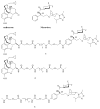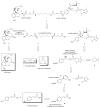Design and synthesis of a bivalent ligand to explore the putative heterodimerization of the mu opioid receptor and the chemokine receptor CCR5
- PMID: 22354464
- PMCID: PMC4374901
- DOI: 10.1039/c2ob06801j
Design and synthesis of a bivalent ligand to explore the putative heterodimerization of the mu opioid receptor and the chemokine receptor CCR5
Abstract
The bivalent ligand approach has been utilized not only to study the underlying mechanism of G protein-coupled receptors dimerization and/or oligomerization, but also to enhance ligand affinity and/or selectivity for potential treatment of a variety of diseases by targeting this process. Substance abuse and addiction have made both the prevention and the treatment of human immunodeficiency virus (HIV) infection more difficult to tackle. Morphine, a mu opioid receptor (MOR) agonist, can accelerate HIV infection through up-regulating the expression of the chemokine receptor CCR5, a well-known co-receptor for HIV invasion to the host cells and this has been extensively studied. Meanwhile, two research groups have described the putative MOR-CCR5 heterodimers in their independent studies. The purpose of this paper is to report the design and synthesis of a bivalent ligand to explore the biological and pharmacological process of the putative MOR-CCR5 dimerization phenomenon. The developed bivalent ligand thus contains two distinct pharmacophores linked through a spacer; ideally one of which will interact with the MOR and the other with the CCR5. Naltrexone and Maraviroc were selected as the pharmacophores to generate such a bivalent probe. The overall reaction route to prepare this bivalent ligand was convergent and efficient, and involved sixteen steps with moderate to good yields. The preliminary biological characterization showed that the bivalent compound 1 retained the pharmacological characteristics of both pharmacophores towards the MOR and the CCR5 respectively with relatively lower binding affinity, which tentatively validated our original molecular design.
Figures







Similar articles
-
A Bivalent Ligand Targeting the Putative Mu Opioid Receptor and Chemokine Receptor CCR5 Heterodimers: Binding Affinity versus Functional Activities.Medchemcomm. 2013 May 1;4(5):847-851. doi: 10.1039/C3MD00080J. Medchemcomm. 2013. PMID: 23682308 Free PMC article.
-
Structure-Based Design and Development of Chemical Probes Targeting Putative MOR-CCR5 Heterodimers to Inhibit Opioid Exacerbated HIV-1 Infectivity.J Med Chem. 2021 Jun 10;64(11):7702-7723. doi: 10.1021/acs.jmedchem.1c00408. Epub 2021 May 23. J Med Chem. 2021. PMID: 34027668 Free PMC article.
-
Exploration of bivalent ligands targeting putative mu opioid receptor and chemokine receptor CCR5 dimerization.Bioorg Med Chem. 2016 Nov 15;24(22):5969-5987. doi: 10.1016/j.bmc.2016.09.059. Epub 2016 Sep 26. Bioorg Med Chem. 2016. PMID: 27720326 Free PMC article.
-
Bivalent ligands targeting chemokine receptor dimerization: molecular design and functional studies.Curr Top Med Chem. 2014;14(13):1606-18. doi: 10.2174/1568026614666140827144752. Curr Top Med Chem. 2014. PMID: 25159160 Free PMC article. Review.
-
Bivalent ligands as specific pharmacological tools for G protein-coupled receptor dimers.Curr Drug Discov Technol. 2008 Dec;5(4):312-8. doi: 10.2174/157016308786733591. Curr Drug Discov Technol. 2008. PMID: 19075611 Review.
Cited by
-
Design of bivalent ligands targeting putative GPCR dimers.Drug Discov Today. 2021 Jan;26(1):189-199. doi: 10.1016/j.drudis.2020.10.006. Epub 2020 Oct 16. Drug Discov Today. 2021. PMID: 33075471 Free PMC article. Review.
-
A Bivalent Ligand Targeting the Putative Mu Opioid Receptor and Chemokine Receptor CCR5 Heterodimers: Binding Affinity versus Functional Activities.Medchemcomm. 2013 May 1;4(5):847-851. doi: 10.1039/C3MD00080J. Medchemcomm. 2013. PMID: 23682308 Free PMC article.
-
Revolution in GPCR signalling: opioid receptor heteromers as novel therapeutic targets: IUPHAR review 10.Br J Pharmacol. 2014 Sep;171(18):4155-76. doi: 10.1111/bph.12798. Br J Pharmacol. 2014. PMID: 24916280 Free PMC article. Review.
-
Structure-Based Design and Development of Chemical Probes Targeting Putative MOR-CCR5 Heterodimers to Inhibit Opioid Exacerbated HIV-1 Infectivity.J Med Chem. 2021 Jun 10;64(11):7702-7723. doi: 10.1021/acs.jmedchem.1c00408. Epub 2021 May 23. J Med Chem. 2021. PMID: 34027668 Free PMC article.
-
Biased, Bitopic, Opioid-Adrenergic Tethered Compounds May Improve Specificity, Lower Dosage and Enhance Agonist or Antagonist Function with Reduced Risk of Tolerance and Addiction.Pharmaceuticals (Basel). 2022 Feb 10;15(2):214. doi: 10.3390/ph15020214. Pharmaceuticals (Basel). 2022. PMID: 35215326 Free PMC article. Review.
References
Publication types
MeSH terms
Substances
Grants and funding
LinkOut - more resources
Full Text Sources
Other Literature Sources
Research Materials

